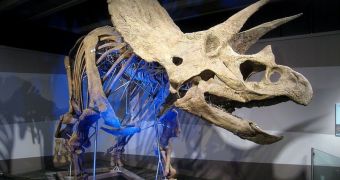A new study published in the latest issue of the esteemed scientific journal Biology Letters indicates that placental mammals existed when dinosaurs still roamed the Earth. Previous studies argue that these creatures only developed after the Cretaceous–Paleogene (K-T) extinction event, 65 million years ago.
This extinction is believed to have been caused by a massive asteroid impact that created the Chicxulub feature in the Gulf of Mexico, a massive, 180-kilometer (112-mile) wide crater. The space object was so large that the force of its impact created a prolonged winter which stopped photosynthesis in plants.
Sunlight may have also been blocked for a few thousands of years, making it impossible for vegetation to grow. Herbivore dinosaur populations were most likely the first to decline, followed promptly by predators. Scientists until now believed that it was the disappearance of dinosaurs that enabled placental mammals to develop.
The term placental mammal is used to denote a mammal that gives birth to live offspring, after feeding them through a placenta while still in the womb. By comparison, dinosaurs laid eggs, meaning that they did not feed their offspring in utero.
A study published in early 2013 analyzed the fossil record, and concluded that placental mammals only appeared after the K-T event. The work was led by Stony Brook University evolutionary biologist Maureen O’Leary, and created quite a debate in the international scientific community.
The new Biology Letters study, authored by University of Bristol palaeobiologist Phil Donoghue and University College London evolutionary geneticists Mario dos Reis and Ziheng Yang, argues that looking exclusively at fossils, while completely ignoring the genetic record, led O'Leary's team to the wrong conclusion.
The 2013 paper was “an incredibly impressive study in all aspects – except the timescale in evolutionary history. What we were really concerned about is that this stuff was going to end up in textbooks,” Donoghue says, quoted by Nature News.
In his own study, the expert used mathematical models and genome data from several mammal species to determine how far back the family tree of placental mammals extends. Results suggest that these creatures first developed between 108 and 72 million years ago, meaning that they co-existed with dinosaurs for 7 to 43 million years.
These conclusions go a long way towards explaining the rich evolutionary diversity of placental mammals after the K-T extinction. Within a couple of million years of the asteroid impact, multiple species already existed.
If these creatures had not evolved before the impact, then this diversity would have implied the existence of very fast-moving evolutionary mechanisms, something which did not happen in other animal groups throughout history.

 14 DAY TRIAL //
14 DAY TRIAL //